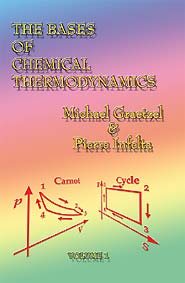
The Bases of Chemical Thermodynamics
Volume 1
by Pierre Infelta & Michael Graetzel
- Number of Pages: 298
- ISBN-10: 1581127723
- ISBN-13: 9781581127720
- Publisher: Universal-Publishers
- Year: 2002
- Category: Physics & Chemistry, Textbooks & Study Guides
Synopsis
In this volume (volume 1), the tools necessary to study and understand systems in which chemical reactions can take place are developed. The variables of reaction are the keys to this understanding. Criteria for chemical equilibrium are established. It is shown how chemical reactions can provide work as, for example, in batteries. For complex systems, the number of independent reactions and their nature have to be determined systematically. The effect of external factors on chemical equilibria is analyzed and illustrated. The formalism necessary to study ideal and real solutions is provided. The various standard states in use and the corresponding activity coefficients are clearly defined.In volume 2, the tools necessary to study and understand systems in which chemical reactions can take place are developed. The variables of reaction are the keys to this understanding. Criteria for chemical equilibrium are established. It is shown how chemical reactions can provide work as, for example, in batteries. For complex systems, the number of independent reactions and their nature have to be determined systematically. The effect of external factors on chemical equilibria is analyzed and illustrated. The formalism necessary to study ideal and real solutions is provided. The various standard states in use and the corresponding activity coefficients are clearly defined. The statistical aspect of thermodynamics is best understood once students are familiar with the rest of the book and, for this reason, is treated in the last chapter.
Both volumes comply with the latest IUPAC recommendations for symbols. Most of the specific mathematical tools are presented either directly in the text if they are used mostly in one chapter, while others are included in an appendix. A primarily phenomenological approach has been selected to keep chemical thermodynamics easily accessible to beginners. Intermediate steps in the derivations have been kept to enhance the clarity of the presentation. A large number of problems, most of them original, all with complete solutions, are provided. They give this textbook a great pedagogical value. This book is primarily destined to students, graduate students and practicing scientists in the fields of Chemistry, Chemical Engineering and Material Sciences.
A condensed Introductory text is also available in both English and French.
About the Author
Michael Graetzel is currently a professor at the Ecole Polytechnique de Lausanne, Switzerland, where he directs the Laboratory of Photonics and Interfaces. He pioneered research on energy and electron transfer reactions in mesoscopic-materials and their optoelectronic applications and discovered a new type of solar cell based on dye sensitized mesoscopic oxide particles and pioneered the use of nanomaterials in lithium ion batteries. Author of over 500 publications, two books and inventor or co-inventor of over 40 patents he was an invited professor at the University of California at Berkeley, the Ecole Nationale Supérieure de Cachan (Paris) and is presently part-time distinguished visiting professor at the Delft University of Technology. He was a frequent guest scientist at the National Renewable Energy Laboratory (NREL) in Golden Colorado, was a fellow of the Japanese Society for the Promotion of Science. He has received numerous awards including the Millenium 2000 European innovation prize, the 2001Pierre Infelta is currently a senior scientist at Ecole Polytechnique de Lausanne, Switzerland. His research areas include photochemistry, microheterogeneous media, chemical kinetics, electron transfer, and solar energy conversion. He has been active in teaching thermodynamics for the past thirty years in the Chemistry and Materials science department at the Ecole Polytechnique Federale de Lausanne in Switzerland. He received his bachelor degree at the Paris University, the Sorbonne and a Chemical Engineering degree at the Ecole superieure de Physique et Chimie Industrielles de Paris. After one year of research work in France in photochemistry, he went to to the Mellon institute of research in Pittsburgh, Pa as a Research Associate for 2 years and subsequently received his PhD from Carnegie mellon University. He has done Postdoc work at the university of Notre Dame, Indiana and worked as a research scientist in the Interuniversitair Reactor Institute in Delft, The Netherlands. He is also the author of several several respected articles and books promoting chemical education in both English and French.




 View or Post a Review at Amazon.com
View or Post a Review at Amazon.com